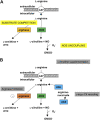Arginine Therapy for Lung Diseases
- PMID: 33833679
- PMCID: PMC8022134
- DOI: 10.3389/fphar.2021.627503
Arginine Therapy for Lung Diseases
Abstract
Nitric oxide (NO) is produced by a family of isoenzymes, nitric oxide synthases (NOSs), which all utilize L-arginine as substrate. The production of NO in the lung and airways can play a number of roles during lung development, regulates airway and vascular smooth muscle tone, and is involved in inflammatory processes and host defense. Altered L-arginine/NO homeostasis, due to the accumulation of endogenous NOS inhibitors and competition for substrate with the arginase enzymes, has been found to play a role in various conditions affecting the lung and in pulmonary diseases, such as asthma, chronic obstructive pulmonary disease (COPD), cystic fibrosis (CF), pulmonary hypertension, and bronchopulmonary dysplasia. Different therapeutic strategies to increase L-arginine levels or bioavailability are currently being explored in pre-clinical and clinical studies. These include supplementation of L-arginine or L-citrulline and inhibition of arginase.
Keywords: Pulmonary hypertension; airway hyperresponsiveness; asthma; asymmetric dimethyl arginine; chronic obstructive pulmonary desease; cystic fibrosis; remodeling.
Copyright © 2021 Scott, Maarsingh, Holguin and Grasemann.
Conflict of interest statement
The authors declare that the research was conducted in the absence of any commercial or financial relationships that could be construed as a potential conflict of interest.
Figures

Similar articles
-
Arginase and arginine dysregulation in asthma.J Allergy (Cairo). 2011;2011:736319. doi: 10.1155/2011/736319. Epub 2011 Apr 26. J Allergy (Cairo). 2011. PMID: 21747870 Free PMC article.
-
Arginase and pulmonary diseases.Naunyn Schmiedebergs Arch Pharmacol. 2008 Aug;378(2):171-84. doi: 10.1007/s00210-008-0286-7. Epub 2008 Apr 24. Naunyn Schmiedebergs Arch Pharmacol. 2008. PMID: 18437360 Free PMC article. Review.
-
Arginine homeostasis in allergic asthma.Eur J Pharmacol. 2008 May 13;585(2-3):375-84. doi: 10.1016/j.ejphar.2008.02.096. Epub 2008 Mar 18. Eur J Pharmacol. 2008. PMID: 18410920 Review.
-
Arginine and asthma.Nestle Nutr Inst Workshop Ser. 2013;77:1-15. doi: 10.1159/000351365. Epub 2013 Aug 29. Nestle Nutr Inst Workshop Ser. 2013. PMID: 24107492
-
Nitric oxide and L-arginine deficiency in cystic fibrosis.Curr Pharm Des. 2012;18(5):726-36. doi: 10.2174/138161212799315911. Curr Pharm Des. 2012. PMID: 22229575 Review.
Cited by
-
L-Citrulline in Neonates: From Bench to Bed Side.Children (Basel). 2024 Dec 30;12(1):42. doi: 10.3390/children12010042. Children (Basel). 2024. PMID: 39857873 Free PMC article. Review.
-
The relationship between genetic prediction of 486 blood metabolites and the risk of COPD: mendelian randomization study.Sci Rep. 2025 Mar 1;15(1):7349. doi: 10.1038/s41598-025-92216-0. Sci Rep. 2025. PMID: 40025290 Free PMC article.
-
Dysregulated Arginine Metabolism in Young Patients with Chronic Persistent Asthma and in Human Bronchial Epithelial Cells.Nutrients. 2021 Nov 17;13(11):4116. doi: 10.3390/nu13114116. Nutrients. 2021. PMID: 34836371 Free PMC article.
-
Regulated Arginine Metabolism in Immunopathogenesis of a Wide Range of Diseases: Is There a Way to Pass between Scylla and Charybdis?Curr Issues Mol Biol. 2023 Apr 18;45(4):3525-3551. doi: 10.3390/cimb45040231. Curr Issues Mol Biol. 2023. PMID: 37185755 Free PMC article. Review.
-
Salidroside enhances NO bioavailability and modulates arginine metabolism to alleviate pulmonary arterial hypertension.Eur J Med Res. 2024 Aug 17;29(1):423. doi: 10.1186/s40001-024-02016-x. Eur J Med Res. 2024. PMID: 39152472 Free PMC article.
References
-
- Belik J., Stevens D., Pan J., Shehnaz D., Ibrahim C., Kantores C., et al. (2009). Chronic hypercapnia downregulates arginase expression and activity and increases pulmonary arterial smooth muscle relaxation in the newborn rat. Am. J. Physiol. Lung Cell. Mol. Physiol. 297 (4), L777–L784. 10.1152/ajplung.00047.2009 - DOI - PubMed
Publication types
LinkOut - more resources
Full Text Sources
Other Literature Sources

